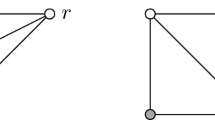Abstract
Considering some classes of polynomial cooperative games, we describe the integral representation of the Shapley values and the support functions of their cores. Also, we analyze the relationship between the Shapley values and the polar forms of homogeneous polynomial games. The found formula for the support function of the core of a convex game is applied for the dual description of the Harsanyi sets of finite cooperative games. The main peculiarity of the proposed approach to the study of optimal solutions of game theory is a systematic use of the extensions of polynomial set functions to the corresponding measures on symmetric powers of the initial measure spaces.
Similar content being viewed by others
Notes
The synonym Shapley vector is also used in the literature (see, for example, [2]).
In what follows, when the indication of the feasibility of the domain of definition of the functions of the class \( {\mathcal{K}}\subseteq{\mathcal{V}} \) under consideration is relevant, we use the more detailed notation \( {\mathcal{K}}(B) \).
The polar form of a homogeneous polynomial functional \( L \) of order \( n \) on a vector space \( X \) is the function \( L^{*}:X^{n}\rightarrow{} \) defined by the formula \( L^{*}(x_{1},\dots,x_{n}):=\frac{1}{n!}\sum\nolimits_{\omega\subseteq\{1,\dots,n\}}(-1)^{n-|\omega|}L(\sum\nolimits_{i\in\omega}x_{i}) \) (see, for example, [16, 18]).
Recall (see [2]) that a finite game \( v\in V(Q) \) is called convex if \( v(e\cup e^{\prime})+v(e\cap e^{\prime})\geq v(e)+v(e^{\prime}) \) for all \( e,e^{\prime}\subseteq Q \).
As usual, for \( x=(x_{i})_{i\in Q}\in{}^{Q} \) and \( e\subseteq Q \), we put \( x(e):=\sum\nolimits_{i\in e}x_{i} \).
A player \( i\in e \) is called \( \pi \)-first (\( \pi \)-last) in \( e \) if all remaining player in \( e \) succeed \( i \) (precede \( i \)).
A function \( \beta \) is called supermodular if \( \beta(e_{1}\cup e_{2})+\beta(e_{1}\cap e_{2})\geq\beta(e_{1})+\beta(e_{2}) \) for all \( e_{1},e_{2}\in{\mathcal{L}} \) (when there is always equality instead of inequality, \( \beta \) is called additive).
References
Aumann R. J. and Shapley L. S., Values for Non-Atomic Games, Princeton University, Princeton (1974).
Rosenmüller J., Kooperative Spiele und Märkte, Springer, Heidelberg (1971).
Bondareva O. N., “Some applications of linear programming to the theory of cooperative games,” Probl. Cybernet., vol. 10, 119–140 (1963).
Marinacci M. and Montrucchio L., “Stable cores of large games,” Intern. J. Game Theory, vol. 33, no. 2, 189–213 (2005).
Vasil’ev V. A., “The Shapley functional and the polar form of homogeneous polynomial games,” Siberian Adv. Math., vol. 8, no. 4, 109–150 (1998).
Vasil’ev V. A., “Nonadditive integration and some solutions of cooperative games,” Mat. Teor. Igr Pril., vol. 13, no. 1, 5–27 (2021).
Vasil’ev V. A., “Support function of the core of a convex cooperative game,” Optimization, vol. 21, 30–35 (1978).
Vasil’ev V. A. and Zuev M. G., “Support function of the core of a convex cooperative game on a metric compactum,” Optimization, vol. 44, 155–160 (1988).
Vulikh B. Z., Introduction to the Theory of Partially Ordered Spaces, Wolters–Noordhoff, Groningen (1967).
Kantorovich L. V. and Akilov G. P., Functional Analysis, Pergamon, Oxford and New York (1982).
Vasil’ev V. A., “Polar representation of Shapley value: nonatomic polynomial games,” Contrib. Game Theory Management, vol. 6, 434–446 (2013).
Owen G., “Multilinear extensions of games,” J. Management Sci., vol. 18, no. 5, 64–79 (1972).
Vasil’ev V. A., “One axiomatization of generalized Owen extension,” Mat. Teor. Igr Pril., vol. 1, no. 2, 3–13 (2009).
Vasil’ev V. A., “On a space of nonadditive set functions,” Optimization, vol. 16, 99–120 (1975).
Aliprantis C. D. and Border K. C., Infinite Dimensional Analysis, Springer, Berlin (1994).
Hille E. and Phillips R. S., Functional Analysis and Semigroups, Amer. Math. Soc., Providence (1957).
Vasil’ev V. A., “The general characteristics of polynomial set functions,” Optimization, vol. 14, 101–123 (1974).
Vasil’ev V. A., “Polar forms, \( p \)-values, and the core,” in: Approximation, Optimization and Mathematical Economics, Physica, Heidelberg and New York (2001), 357–368.
Vasil’ev V. A., “The Shapley value for games of bounded polynomial variation,” Optimization, vol. 17, 5–26 (1975).
Lyapunov A. A., The Problems of the Theory of Sets and the Theory of Functions, Nauka, Moscow (1979) [Russian].
Dehez P., “On Harsanyi dividends and asymmetric values,” Intern. Game Theory Rev., vol. 19, no. 3, 1–36 (2017).
Vasil’ev V. A., “Cores and generalized NM-solutions for some classes of cooperative games,” in: Russian Contributions to Game Theory and Equilibrium Theory. (T. S. H. Driessen, G. van der Laan, V. Vasil’ev, E. Yanovskaya, eds.), Springer, Berlin, Heidelberg, and New York (2006), 91–149.
Vasil’ev V. A., “Weber polyhedron and weighted Shapley values,” Intern. Game Theory Rev., vol. 9, no. 1, 139–150 (2007).
Vasil’ev V. A. and van der Laan G., “The Harsanyi set for cooperative \( TU \)-games,” Siberian Adv. Math., vol. 12, no. 2, 97–125 (2002).
Kindler J., “A Mazur–Orlicz type theorem for sub-modular functions,” J. Math. Anal. Appl., vol. 120, 533–546 (1986).
Funding
The work was supported by the Program of Basic Scientific Research of the Siberian Branch of the Russian Academy of Sciences (Grant no. 0314–2019–0018) and the Russian Foundation for Basic Research (Grant no. 19–10–00910).
Author information
Authors and Affiliations
Corresponding author
Additional information
Translated from Sibirskii Matematicheskii Zhurnal, 2022, Vol. 63, No. 1, pp. 77–94. https://doi.org/10.33048/smzh.2022.63.105
Rights and permissions
About this article
Cite this article
Vasil’ev, V.A. On the Core and Shapley Value for Regular Polynomial Games. Sib Math J 63, 65–78 (2022). https://doi.org/10.1134/S0037446622010050
Received:
Revised:
Accepted:
Published:
Issue Date:
DOI: https://doi.org/10.1134/S0037446622010050
Keywords
- polynomial cooperative game
- Shapley value
- support function of the core
- generalized Owen extension
- \( (v,c) \)-integral




